Pomegranates: Care, Growing Guide, Seeds, Pruning, Flowers
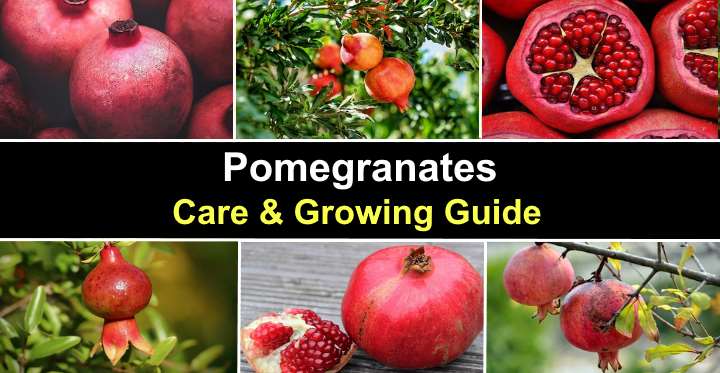
Pomegranates are delicious apple-sized red fruits with a thick, leathery skin surrounding juicy seed-containing pods (arils). Pomegranate fruit grows on small to large shrubs or small ornamental trees, and the flowering plants thrive in warmer climates. In the right conditions, pomegranate trees are easy to grow and are ready for harvesting in the winter. The tasty arils are delicious fresh, or you can make pomegranate juice, add the pods to salads, or use them in cooking.
Although pomegranates are easy to grow in a warm climate, some issues can affect their growth. For example, pomegranate fruit can split on the tree if left too long. Or leaf-footed bugs can infest the fruits, causing them to rot. However, you can easily grow pomegranate trees in your garden to enjoy these tasty fruits with the proper care.
This article is a comprehensive guide to growing pomegranates at home or in your garden. In addition to handy tips on pomegranate tree care, you will learn how to tell when pomegranates are ripe for picking.
How to Grow Pomegranate
To grow a pomegranate, plant the shrub (or tree) where it gets plenty of sunlight. Ideally, growing a pomegranate plant requires at least six hours of direct sunlight daily. For healthy growth, the pomegranate should grow in relatively fertile, well-drained soil. For adequate soil moisture, regularly water the pomegranate tree.
Once established, pomegranate bushes are relatively drought-tolerant plants. However, regular watering will ensure excellent flowering and fruit growth. It is also good to apply a thick layer of compost when leaves appear in late winter or early spring.
Pruning pomegranate trees also encourages large pomegranates to grow. You can prune branches after the leaves have dropped to maintain the tree’s size. Additionally, thinning pomegranate fruit to one every 6 inches helps to promote larger fruit growth.
What is Pomegranate?

Pomegranate is a shrub or multi stemmed tree that usually grows between 10 and 12 ft. (3 – 3.6 m) high
Pomegranate (Punica granatum) is a deciduous shrub in the flowering plant family Lythraceae. Although pomegranate is a multi-stemmed shrub, most people grow it as a tree in their garden. Pomegranates are widely grown in the Mediterranean region, the Middle East, tropical Africa, Central Asia, and the Indian subcontinent.
The name pomegranate means “seeded apple.” This description fairly accurately describes the pomegranate appearance due to its roundish shape and seed-filled interior. Although pomegranates typically have red skin, there are also orange, yellow, pink, and black varieties.
When talking about pomegranates, most people refer to the large red ball-like fruit. Pomegranate fruits have a smooth leathery skin and six sides. Inside, the fruit is divided into several compartments containing juicy red arils, each containing a pomegranate seed. Pomegranates are identified by their shiny skin and crown-like structure on their base.
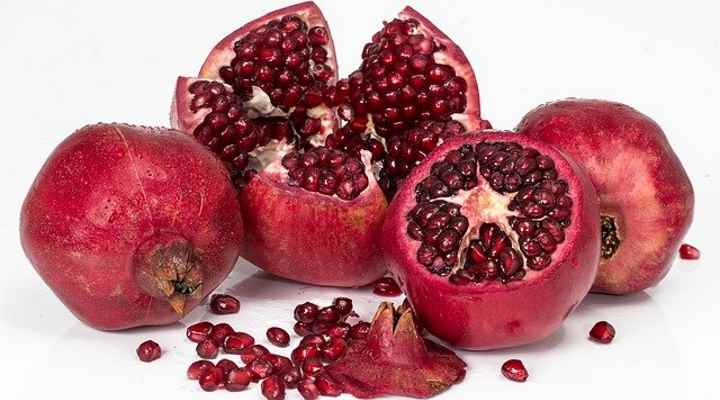
Pomegranate fruit
Pomegranate fruit can have a sweet or tangy taste.
Pomegranate trees have glossy oval to oblong green leaves with a leathery texture growing in a vase shape. The leaves grow in whorls of five or more and measure 1” to 4” (2.5 – 10 cm) long. Pomegranate shrub-like tree grows between 10 and 12 ft. (3 – 3.6 m) high and up to 10 ft. (3 m) wide.
Pomegranates thrive in USDA zones 8 through 10.
Varieties of Pomegranate to Grow at Home
There are over 500 cultivars of pomegranate (Punica granatum), and some cultivars are easier to grow than others. In addition, some pomegranate varieties have a sweet taste and grow well in USDA zone 7.
Here are some popular varieties of pomegranates that grow in southern states:
- Sweet—As the name implies, this type of pomegranate has sweet flesh and pink skin. The pomegranate tree produces large fruit in abundance.
- Sienivyi—This variety is a large, soft-seeded pomegranate with a sweet taste. It’s one of the most popular pomegranate varieties.
- Angel Red—This pomegranate has bright red skin and arils. Its flesh is exceptionally juicy and is popular for making pomegranate juice.
- Balegal—A hardy variety of pomegranate for growing in zone 7 that produces large fruits with sweet flesh.
- Wonderful—Suited to hot, arid landscapes, the pomegranate has large red fruits with a tangy flavor and soft seeds.
Pomegranate Tree Pollination
Pomegranate flowers are perfect flowers (flowers that have both stamens and pistils in the same structure) that can self-pollinate. However, the bright-red, orange or pink showy flowers also attract pollinators. Insect pollinators and hummingbirds can also cross-pollinate the flowers with flowers from the same plant or other plants. Because pomegranate is self-pollinating, you only need one tree or bush to grow fruit.
Pomegranate Tree Flowers
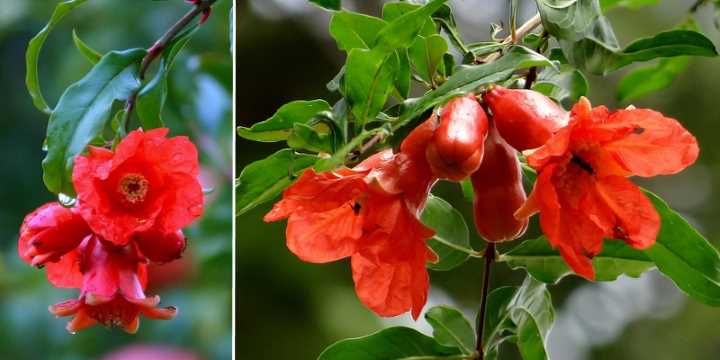
Pomegranate flowers
Pomegranate flowers are typically showy red trumpet-shaped flowers that have fused petals and a crepe paper texture. The ruffled flowers can be single or double flowers and measure around 1” (2.5 cm) wide. Pomegranate flowers appear on new wood, which means you should only prune them when the tree is dormant.
Most pomegranate flowers are perfect flowers—meaning that flowers contain both male and female parts. However, some male (single-sex) pomegranate flowers also grow on the bush. These typically fall off after they produce pollen. Therefore, you shouldn’t be worried if you see flowers dropping.
How to Grow Pomegranate Plant in a Pot
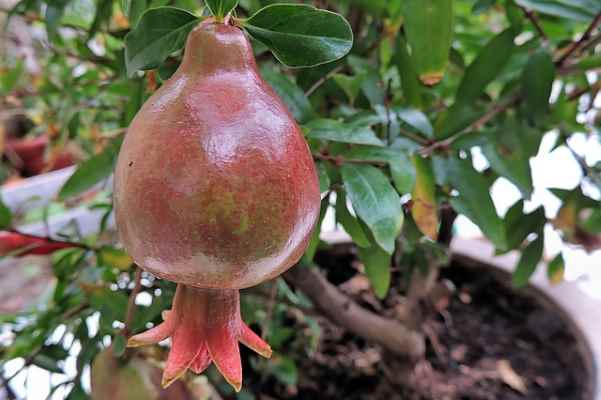
Potted pomegranate
A small pomegranate tree is perfect for growing in a container. You should plant the dwarf pomegranate tree in a 10-gallon (38 l) container containing well-draining soil—loamy soil is ideal. Ensure that there are drainage holes on the base of the pot to allow excess water to escape.
To grow a potted pomegranate tree, place the container in full sun outdoors or beside a sunny window indoors. Water the tree enough to maintain evenly moist soil, especially as harvest approaches. During hot summer spells, deep watering once or twice a week may be necessary.
You should also fertilize the potted pomegranate plant regularly during the growing season. A balanced liquid fertilizer with an NPK rating of 10-10-10 is ideal for applying twice a year in late fall (November) and early spring (February). If you notice yellowing foliage, you may need to spray diluted zinc solution on the leaves.
Growing pomegranates in pots is suitable if you live in a colder climate. You can place the pot in a sunny location in your garden during the summer months. Then bring the pot indoors when the temperature drops below 40°F (4°C). When growing indoors, place the pomegranate container near a sunny window, but protected from the direct midday sun.
How to Plant a Pomegranate Tree
Pomegranate is typically a multi-stemmed plant with a shrub form. Therefore, to grow a pomegranate as a beautiful fruit tree it requires regular maintenance and pruning. However, a pomegranate in a tree form can grow up to 20 ft. (6 m) tall when appropriately trained.
To encourage a bushy pomegranate shrub to grow as a tree, you must remove the suckers around the main trunk. During the first year, let the pomegranate grow without pruning. Then during the second year, remove suckers except from the four strongest-looking sprouts. During the growing season, continue to cut the emerging stems. The pomegranate should develop a tree-like stocky framework.
An essential factor to remember is that a newly-planted pomegranate tree needs plenty of water during the first year of growth. This means watering the root system deeply once or twice a week, depending on soil drainage.
Where to Grow Pomegranate Plants
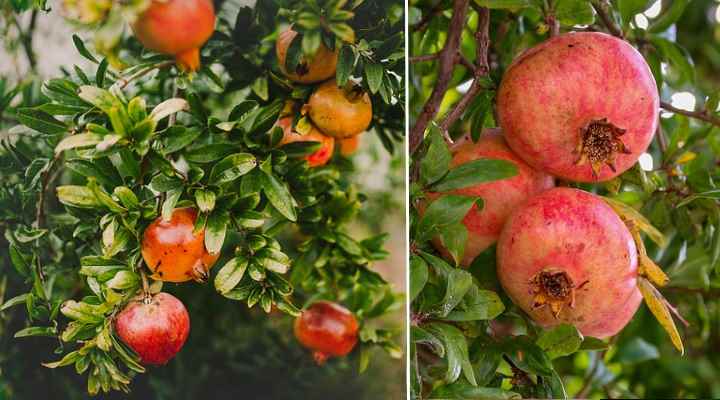
Pomegranate trees or bushes require plenty of sunlight and well-draining slightly acidic soil
Picking the ideal location in your garden is vital to ensure a bumper crop of sweet, juicy pomegranate fruits. The two primary requirements for growing pomegranates in the ground are plenty of sunlight and slightly acidic soil that drains well. Moderately alkaline soil is acceptable, but the tree won’t grow as well.
For a healthy pomegranate tree, choose the sunniest location in your garden. When growing pomegranates, more sunshine means more fruit. A pomegranate tree is tolerant of some shade; however, it won’t produce as many delicious red fruits. Additionally, a sheltered location will help to protect the tree from any chance of frost damage.
Average garden soil is acceptable for growing a pomegranate bush, as long it drains well, and you keep the ground moist.
To test soil drainage, dig a hole 12 inches wide by 12 inches (30 cm by 30 cm). Then, fill the hole with water to test how long it takes to drain. In well-drained soil, the water level should reduce by 1” (2.5 cm) per hour. A slower rate may indicate clay, compacted soil. However, if it drains too fast, the sandy soil may not hold enough moisture.
How to Water a Pomegranate Tree
Pomegranate trees need sufficient water to produce abundant healthy fruit. To water a pomegranate tree correctly, provide around 1” (2.5 cm) of water every week. During dry periods, water the tree more often to keep the soil moist. Additionally, pomegranate trees growing in sandy soils need more frequent watering than those in clay soils.
Although a pomegranate tree is relatively drought-tolerant, it needs regular watering to produce good quality fruit. If growing in overly dry conditions, fruit production may be poor, and the pomegranate fruits may suffer premature drop.
Temperature and Humidity for Growing Pomegranates
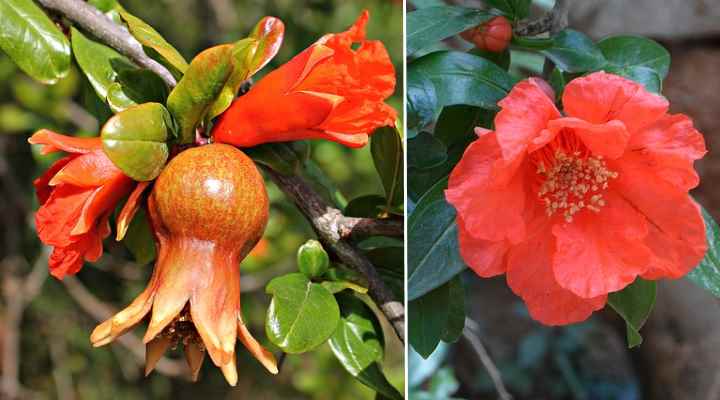
Most pomegranate trees grow well in USDA zones 8 – 10 with some hardy varieties suitable for zone 7
Pomegranates require hot summers and cool winters to produce an abundant harvest. The ornamental tree thrives in USDA zones 8 through 10. However, some cultivars are also suitable for zone 7. The ideal temperature range for growing pomegranates is 73°F to 90°F (23° – 32°).
The hardiest pomegranate trees can cope with temperatures as low as 10° (-12°C). But if you commonly get freezing weather, it’s best to grow a pomegranate shrub in a container, similar to a citrus potted plant.
To produce ripe, delicious fruits, pomegranates should grow in drier conditions indoors. Too much humidity can affect flower production and ultimately result in a poor harvest or rotten fruit.
Pomegranate Tree Fertilizer
Pomegranate trees benefit from adding organic compost or rotted manure to the soil to maintain acid soil conditions. The best time to fertilize a pomegranate shrub is in spring. Add a thick layer of mulch with compost over the entire root area, leaving about 5 inches (13 cm) clear from the main stem.
It’s good to note that fertilizing in summer or fall can result in a poor harvest. This is because extra nutrients encourage new growth in late fall, which can get damaged if there is a frost. However, it is acceptable to add compost to the tree’s root area in November.
Pomegranate Tree Pruning

Pruning pomegranate tree helps to boost fruit production or improve its appearance
Pruning a pomegranate tree is an ideal way to boost fruit production. But pruning is also excellent if you are growing an ornamental pomegranate tree to enhance its appearance.
Pomegranate tree pruning for decorative purposes entails thinning the branches. In late winter, after the risk of frost has passed, prune crossed-over branches in the center of the vase-shaped crown. In addition, look for diseased, weak, and straggly branches to remove. At the same time, remove any suckers if you are growing a pomegranate tree.
Pruning a pomegranate tree for fruit production requires shortening the branches. Then, in early spring, cut back the exterior branches to allow smaller side shoots to grow. This type of pruning encourages flowering and fruiting buds to appear.
Suppose you have a mature pomegranate tree that produces few fruits. In that case, you can severely cut back the branches to encourage the tree to flower and produce a bumper crop of ripe fruit.
Picking Pomegranates – How to Tell If a Pomegranate is Ripe
The time for picking ripe fruit from a pomegranate tree is between August and November. To tell if a pomegranate is ripe, look at the color of the rind and its shape. The apple-sized fruit should turn from a round to a slightly hexagonal shape. In addition, the skin should appear matte, not glossy.
Here are a few additional ways to pick a ripe fruit during pomegranate season:
- The ends of the fruit begin to become flatter.
- It is easy to remove the fruit from the tree. However, it’s best to harvest ripe pomegranates by cutting them off.
- Tap the tough skin and listen for a metallic sound.
The way to tell if a pomegranate is overly ripe is if the fruit splits on the tree.
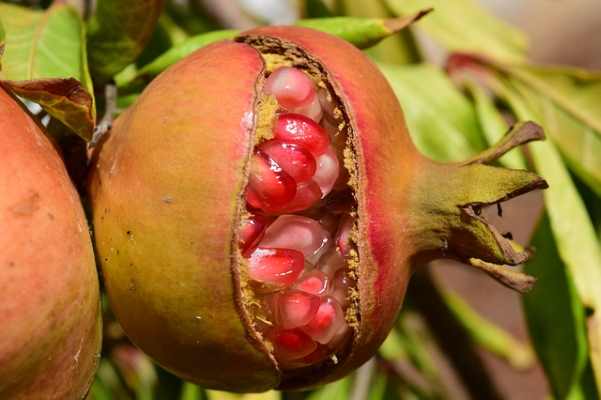
Overripe pomegranate
How to Propagate a Pomegranate Tree
It’s easy to propagate a pomegranate by taking hardwood stem cuttings. In late winter, before any new growth appears, take a few 10-inch (25 cm) cuttings that are 0.25” – 0.5” (0.6 – 1.2 cm) thick. Then dip the cut ends in rooting hormone. After that, plant directly in the ground where you want the new pomegranate to grow.
Space the pomegranate cuttings at least 3 ft. (1 m) apart if you plan to grow a shrub. However, spacing should be around 18 ft. (5.5 m) between stems to grow a few pomegranate trees.
Growing Pomegranates From Seed
It is possible to grow a pomegranate plant from seed. It takes between three and five years for a pomegranate tree to grow from seed and produce fruit. However, propagating pomegranates from seed is tricky and not always successful. Therefore, if you want to grow a new pomegranate, it’s best to get some cuttings.
However, if you want to grow pomegranate from seed, this is what you should do:
Scoop out some pomegranate seeds from ripe fruit in winter. Then wash and dry the seeds and allow them to dry. After that, plant the seeds 0.25” (0.6 cm) deep in some light potting soil. Cover with a clear plastic bag, place on a sunny, warm windowsill, and keep the soil moist. The seedlings should be ready by spring for planting in the garden when any danger of frost has passed.
Pomegranate Care During Fall and Winter
Overwintering a pomegranate tree is necessary when growing the plants in pots in colder climates. To get a pomegranate ready for winter, prune back the potted plant by half. The time for this is about six weeks before the first frost date. Then put the pomegranate pot indoors, near a sunny, south-facing window.
Indoors, maintain a room temperature above 60°F (15°C). Ensure the plant isn’t standing in any cold or hot drafts for healthy growth, and keep the air humidity average. Water the potted plant every ten days so that only the top 1” (2.5 cm) is moist. It is vital to avoid the plant sitting in soggy soil.
Pests and Diseases Affecting Pomegranate Tree
Like all garden plants, pomegranate trees are susceptible to various bugs and plant-destroying insects. Common pests that can affect a pomegranate plant’s growth include aphids, leaf-footed bugs, mealybugs, pomegranate fruit borer, whiteflies, and thrips.
Some bugs, such as mealybugs, feed on the juice of pomegranate plants. In contrast, some butterfly larvae bore into the fruit, destroying it from the inside.
To get rid of bugs from pomegranate plants, use insecticidal soap, a neem oil solution, or use a sharp blast of water from the hose to dislodge aphid eggs and larvae.
Root rot usually causes fungal diseases that affect the appearance of pomegranate leaves. You can avoid this issue by planting a pomegranate tree in well-drained soil and avoiding over-watering the plant. If you notice light brown spots on leaves, you must remove them and ensure the soil drains properly.
A fungal disease called heart rot can affect pomegranate fruit. The disease could be a result of high humidity levels when the shrubs were blooming. Unfortunately, there is no way to cure heart rot in pomegranate fruit.
Related articles:
- Dwarf Fruit Trees to Grow Indoors or Outdoors
- Dwarf Citrus Trees: Caring and Growing Guide
- Types of Cherry Trees – Identification Guide
